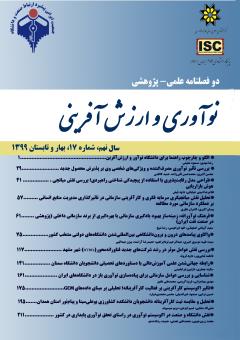نقش دانشگاه و صنعت در اکوسیستم نوآوری در راستای تحقق نوآوری پایداری در کشور
محورهای موضوعی : عمومى
محمد زرین جویی
1
![]() ,
محمدعلی نعمتی
2
*
,
حمیده رشادت جو
3
,
محمدعلی نعمتی
2
*
,
حمیده رشادت جو
3
1 - گروه مدیریت آموزش عالی، دانشکده مدیریت و اقتصاد، دانشگاه آزاد اسلامی واحد علوم و تحقیقات، تهران، ایران
2 - گروه مدیریت آموزش عالی، دانشکده روان شناسی وعلوم تربیتی، دانشگاه علامه طباطبایی، تهران، ایران
3 - گروه مدیریت آموزش عالی، دانشکده مدیریت و اقتصاد، دانشگاه آزاد اسلامی علوم و تحقیقات، تهران، ایران
کلید واژه: اکوسیستم نوآوری, نقش دانشگاه, نقش صنعت, نوآوری پایدار,
چکیده مقاله :
تحقیق حاضر با هدف" بررسی نقش دانشگاه وصنعت دراکوسیستم نوآوری درراستای تحقق نوآوری پایدار" انجام شد. روش پژوهش، آمیخته بود. در بخش کیفی، جامعه آماری شامل کلیه متخصصان حوزه های دانشگاه و صنعت بودند. نمونه آماری برابر20 نفر به روش نمونه گیری هدفمند انتخاب گردید. در بخش کمی، جامعه آماری شامل مدیران میانی و اجرایی حوزه دانشگاه و صنعت بودند که در تهران بودند. در این بخش، از روش نمونه گیری تصادفی طبقه ای استفاده گردید که بدین ترتیب تعداد 205 نفر با این روش انتخاب شدند. دادهها با روش مصاحبه نیمه ساختار یافته و پرسشنامه محقق ساخته جمع آوری شد. برای تحلیل دادههای کیفی از روش تحلیل مضمون و برای تحلیل دادههای کمی از روش حداقل مربعات جزئی استفاده گردید. نتایج نشان داد که نقش های دانشگاه و صنعت شامل شش نقش آموزش، پژوهش، خدمات اجتماعی، کمک به توسعه فناوری، کمک به توسعه نوآوری، کمک به توسعه کار آفرینی است که هریک کار کردهای مربوط به خود را دارند. بر اساس یافته های تحقیق حاضر، نقش های دانشگاه، صنعت، بر اساس شاخص نیکویی برازش از برازش بالایی برخوردار بود. در این الگو هر دو نهاد دانشگاه و صنعت، تاثیر معناداری در اکوسیستم داشتند. نهاد صنعت با بار عاملی بیشتر در جایگاه اول اهمیت نقش آن در ایجاد اکوسیستم و نهاد دانشگاه با بار عاملی کمتر در مرتبه بعدی قرار دارد. معیار قدرت پیش بینی مدل حاکی از آن بود که متغیرهای برون زا یعنی نقش های دانشگاه و صنعت از قدرت پیش بینی کنند گی بالایی برای پیش بینی ایجاد اکوسیستم (ارتباط) دانشگاه، صنعت برخوردارند.
The aim of this study was to The Role of University and Industry in the Ecosystem of Innovation in the line with realization of Sustainable Innovation. The Mixed method was conducted. In the qualitative study, the population was consisted all of the experts in two field of university and industry. A purposive sampling of 20 experts were selected. The In the quantitative section, the statistical population consisted of middle managers and executives of the university and industry field in Tehran. In this section, stratified random sampling method was used, so 205 people were selected by this method. To collect data, semi-structured interviews and questionnaires were used. To analysis of qualitative data, thematic analysis, and for quantitative data partial least square method were used. The results showed that the roles of the university and industry include six roles of teaching, research, social service, help to technology development, help to innovation development, help to entrepreneurship development. Based on the findings of this research, the roles of university, industry, based on the goodness of fit index were highly fitted. In this model, both institutions of the university and industry had a significant impact on the ecosystem. The industry with a higher factor loading was in the first place of the importance of role in creating the ecosystem, and the institution of the university with a lower factor loading was on the next order. The model's power of prediction criterion, indicated that exogenous variables, i.e., university and industry roles, have the potential to predict the formation of the ecosystem (relationship) of the university and the industry
داوری، علی و رضازاده، آرش(1392). مدل¬سازی معادلات ساختاری با نرم¬افزار pls، تهران، انتشارات جهاد دانشگاهی.
2. کرسول ،جان دبلیو، ویکی پلانوکلارک (2010). روش¬های تحقیق تلفیقی،ترجمه عباس زارعی و محسن نیازی (1389)، تهران، انتشارات سخنوران.
3. Adams, Richard; Jean Renaud, Sally; Bessant, John; Denyer, David; Overy, Patrick (2016) Sustainability-oriented Innovation: A Systematic Review. International Journal of Management Reviews , Volume:18 . Issue: 2: 180-205.
4. Ayuso S, Rodríguez MA, García-Castro R, Ariño MÁ. (2011). Does stakeholder engagement promote sustainable innovation orientation. Industrial Management and Data Systems 111(9): 1399–1417.
5. Chin, W.W. (1998). The Partial Least Squares Approach to Structural Equation Modeling. Modern Methods for Business Research, 2, 295-336.
6. Creswell, J.W. and Miller, D.L. (2000) Determining Validity in qualitative inquiry. Theory In to Practice, 39 (3), 124-130
7. Ferretti Marco, Adele Parmentola, (2015) The Creation of Local Innovation Systems in Emerging Countries- The Role of Governments, Firms and Universities. Springer.
8. Goodman Jennifer, Angelina Korsunova and Minna Halme(2018). Our Collaborative Future: Activities and Roles of Stakeholders in Sustainability‐Oriented Innovation, Business Strategy and the Environment.
9. Greenwood M. (2007). Stakeholder engagement: beyond the myth of corporate responsibility. Journal of Business Ethics 74(4): 315–327.
10. Henseler, Jorg; Chin, Wynne W. (2010) A Comparison of Approaches for the Analysis of Interaction Effects Between Latent Variables Using Partial Least Squares Path Modeling. Structural Equation Modeling A Multidisciplinary Journal Volume 17 issue 1.
11. Henseler, J., Ringle, C., M. & Sinkovis, R., R. (2009). The use of partial least squares path modeling in international marketing. New challenges to international marketing advances

